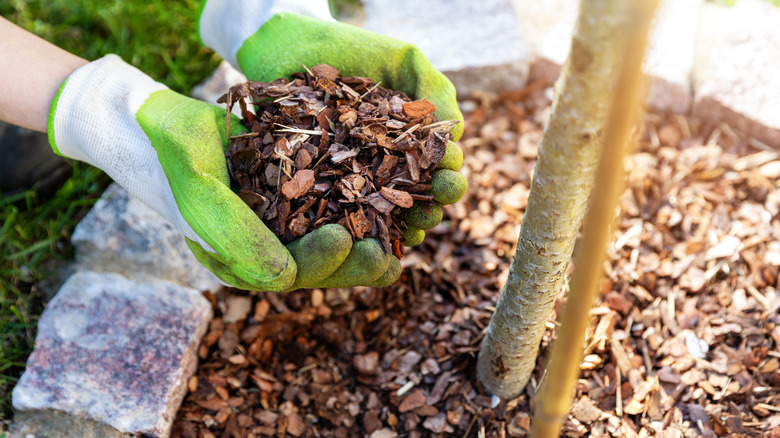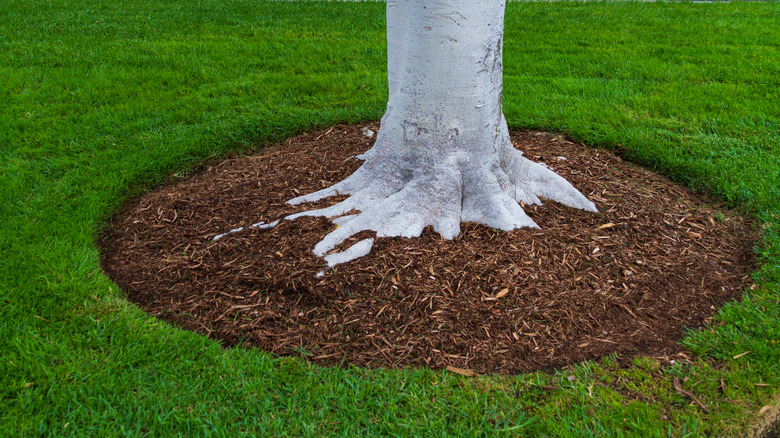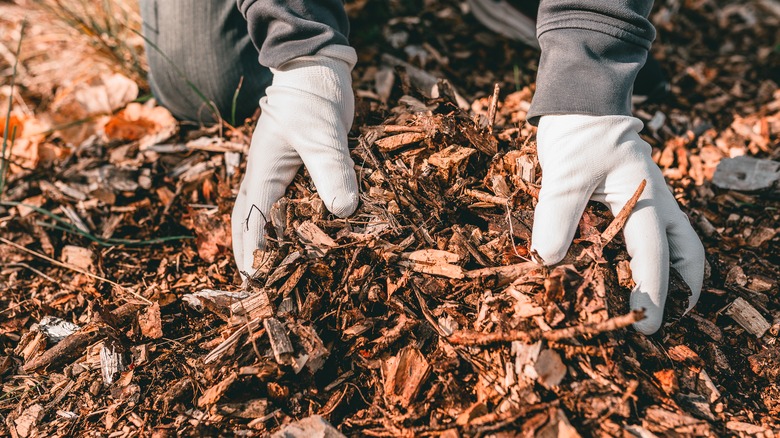The Crucial Mulching Mistake To Avoid Around Trees
While mulch is often used for aesthetic purposes to help make your garden or yard look tidy and well-maintained, mulch can also be quite beneficial for plants. This is especially true for trees because mulch can provide extra insulation, help retain moisture in the soil, and prevent competition from other plants. However, the problem with mulch is that it is often applied incorrectly. Mulch around a tree should be mostly flat instead of arranged in a large mound at the base of the tree. In fact, mulch mountains do more harm than good and can even lead to the slow decline and eventual death of a tree.
According to Ohio State University, mulch mounds (or volcanoes) are damaging to trees because when the mulch is piled against the bark it creates an area of locked-in moisture at the base of the trunk that leads to bark decay. This damage to a tree's bark alone will not kill it, but it will make the tree more susceptible to pests and diseases which can eventually kill the tree. Furthermore, a large mound of mulch at the base of the tree can cause the tree's roots to grow differently to accommodate the mulch. Then, when it eventually decomposes or disappears, the tree roots will be exposed causing dehydration and further tree stress.
How to mulch the right way
So, how can you apply mulch to your trees correctly to keep them both healthy and happy? The first step is to not make a mound. Even though mulch mounds may look aesthetically pleasing, the best thing to do for your tree is to spread the mulch in an even layer around the tree that is about three to four inches deep. Then, once you have your layer of mulch, make sure that none of the mulch is touching the trunk of the tree. You want to make sure the base of the tree (where it flares out slightly) is fully visible and able to breathe. This will ensure that the bark of the tree stays dry and safe from fungal infections and pests.
If possible, you should try to make your mulch ring under an adult tree around four to five feet in diameter to make sure that as much of the root system as possible is covered. The best time to add mulch to a tree is in mid-spring when temperatures rise and the trees start to wake up from their winter dormancy. However, you should always mulch new trees right after you plant them no matter the season — because spring is surprisingly not the best time of year to plant a tree.
Best types of mulch for trees
There are many different kinds of mulch available on the market from natural to synthetic, and the type of mulch you choose may depend on your climate and preferences. However, most arborists suggest using organic mulches like natural wood, aged bark, pine needles, shredded leaves, and compost. The reason these mulches are preferred is because they are made from organic matter which will eventually break down and add beneficial nutrients into the soil.
According to the Sacramento Tree Foundation, the best type of mulch to use under your trees is natural wood chips. This type of mulch is sometimes called arborist mulch and is made from multiple parts of the tree including the bark, leaves, and wood. The best part about arborist mulch is that the pieces are of various sizes which helps to better block out weeds and regulate soil temperature.
The North Carolina Urban Forest Council also agrees that natural wood chips are a great choice to use under trees along with other natural options like bark nuggets, composted leaves, and pine needles. However, the council also warns against using mulch made from walnut or redwood bark because it can contain toxins that inhibit the growth of other trees. They also recommend against using natural mulches that tend to become dense and packed down such as sawdust, finely shredded bark, and grass clippings.


